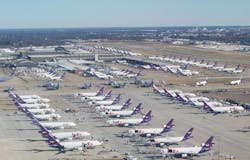The Federal Aviation Administration says it has boosted overall efficiency at the Memphis airport by more than 15 percent by reducing separation between most of FedEx's jets.
The new standards, in place at Memphis since last Nov. 1, will be expanded to other airports with concentrations of heavy, wide-body aircraft, including San Francisco, Louisville and Atlanta, over the next couple years, FAA officials said Wednesday.
"FedEx really sought us out and advocated the program," said David Grizzle, chief operating officer of the FAA's air traffic organization. "They were the among the airlines who were most vocal in articulating the benefit that they thought could be obtained by implementing."
"We will have benefits that are large in other airports that have a preponderance of heavy wide-bodies," Grizzle added. "What is distinct about the FedEx operation is that during its night push, it's overwhelmingly heavy wide-bodies." The FAA projects the change will increase efficiency an average 7 percent at other airports.
The new standards stem from a decade-long collaboration between the FAA, the Department of Transportation's Volpe National Transportation System Center and Eurocontrol, Europe's version of the FAA.
It's part of the FAA's long-range push to overhaul the nation's air traffic system with new technology, equipment and procedures known as NextGen.
"The science is tremendously better now" than when previous standards were written in the mid-1990s, said Scott Pressley, a National Air Traffic Controllers Association representative involved in the process. "With that information we've been able to compact how many airplanes we can get on the ground at a given time or how many airplanes we can get off the ground, without pouring any cement, without building any new infrastructure, just the rules itself, and it's still as safe as it ever was, if not safer."
Minimum spacing between departing aircraft was reduced to 2.5-3 miles, from 4 miles, for most planes used by primary Memphis airport tenant FedEx. Spacing was increased for some smaller planes following larger aircraft. The rules, called wake turbulence separation standards, are designed to ensure that a trailing aircraft avoids dangerous turbulence created by the aircraft ahead of it.
FedEx, with a fleet dominated by MD-11s, Boeing 767s and Airbus A300 series aircraft, has shaved an average three minutes off taxi time by going directly from gate to runway, a 16 percent gain. It's taking 30 seconds less to be cleared for takeoff. It's reducing jet fuel consumption, engine emissions and noise.
FedEx officials were bowled over by the difference the change made as the company moved hundreds of planes in and out of the airport daily in last fall's peak season, FedEx vice president of flight operations Jim Bowman said.
"I've been looking at these numbers for eight years and the first night, I couldn't believe what I was reading," Bowman said.
"In the daytime, we are rarely seeing a queue of airplanes waiting to take off. We are trying to figure out ways to get planes to the runway fast enough to feed what the new program allows us to do."
Increasing capacity through runway construction is expensive and time-consuming, Bowman said. "If we can create bits of runways with this and other efficiencies, we've done a great thing. You haven't taken land out of the area. You haven't impacted more people with noise. It's good for everybody that we don't have to build more runways."
Copyright 2013 - The Commercial Appeal, Memphis, Tenn.





